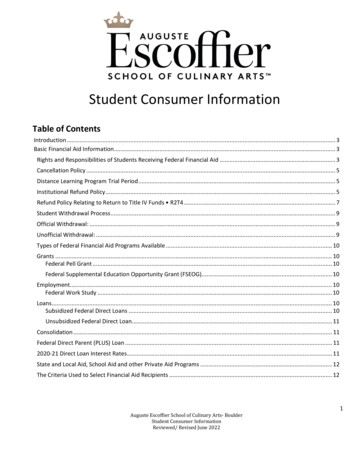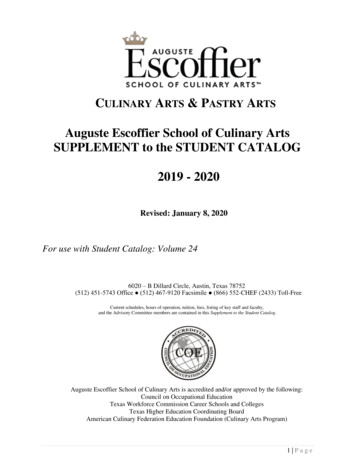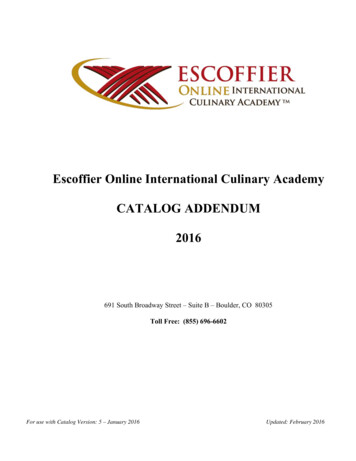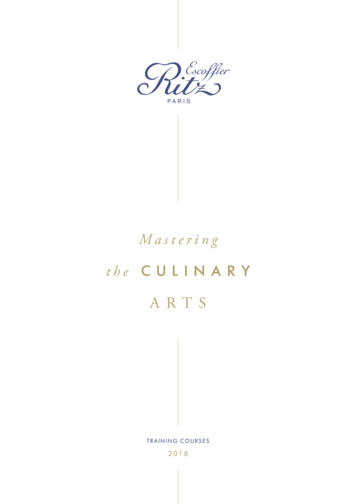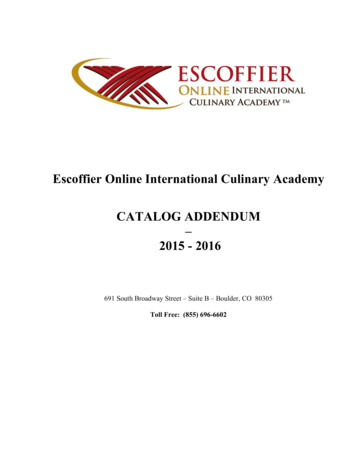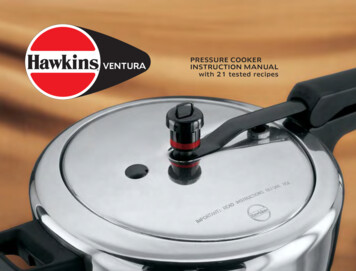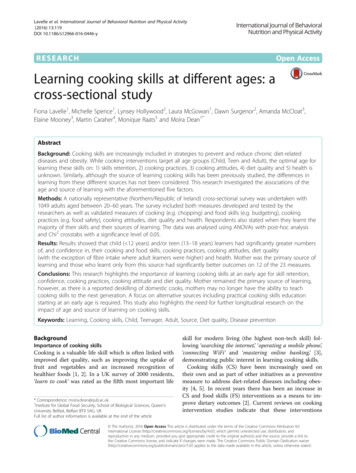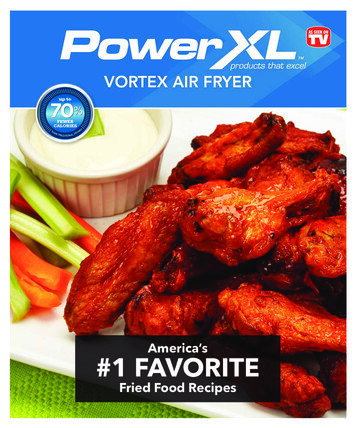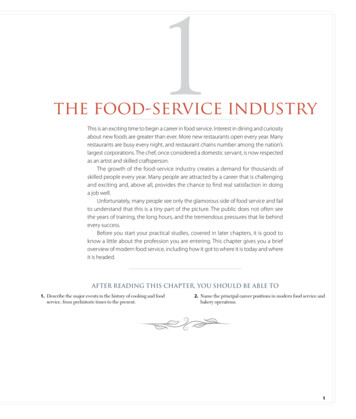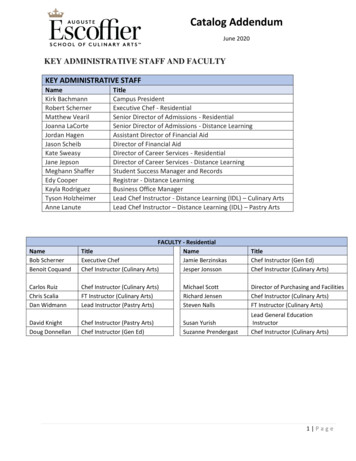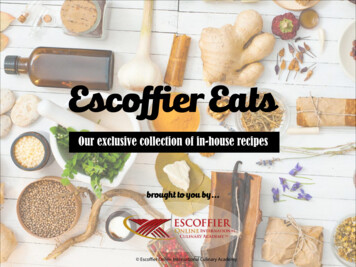
Transcription
13potatoesThe eating habits of most nations place a great deal of importance on a category offoods we call starches. In fact, for a large portion of the world’s peoples, starch is themainstay of the diet and supplies most of the day’s calories. In North America andEurope, the most important starches are potatoes, rice, pasta, and bread. It is true wedo not depend on these high-carbohydrate foods as much as many of the world’speople, who eat far less meat than we do. Nevertheless, even as diet fashions and fadscome and go, starches appear at nearly all our meals.Because we eat them often and have devised a great many ways of preparingthem, starchy foods require extra study beyond that which we give other vegetables.In this chapter, we turn our attention primarily to the preparation of our most important vegetable, the potato. Grains and other starches are discussed in Chapter 14.AFTER READING THIS CHAPTER, YOU SHOULD BE ABLE TO1. Identify the types of potatoes and their quality factors.2. Cook potatoes by boiling and steaming, baking, sautéing, pan-frying,and deep-frying.351
352C h a p t e r 1 3p o tat o e sUNDERSTANDING POTATOESIn classical cuisine, the potato is one of the most important of all foods. To many of us today, potatoes are considered an ordinary and humble food. Escoffier, however, treated the potato with greatrespect. His Guide Culinaire lists more than 50 potato preparations, far more than for any other vegetable or starch.Considering how important the potato is in the cuisines of Europe and North America, it issurprising to think this vegetable wasn’t widely used until the last half of the eighteenth century.Although the potato had been brought to Europe from the New World a few hundred years earlier, it wasn’t until then that an army pharmacist named Antoine-Auguste Parmentier began promoting its use. To this day, many classical recipes featuring the potato are called Parmentier(par mawn tyay).Botanically, the potato is a tuber, which is an enlarged underground stem with buds (oreyes) that become new shoots. Traditional main courses in Western cooking feature a proteinitem, one or more vegetables, and a starch. The potato is, of course, a vegetable, but becauseof its high starch content it usually serves the same function on the menu as grains and otherstarchy foods.Potatoes are traditionally classified as either starchy, low-moisture varieties or as waxy, high-moisture varieties. The following section summarizes the main characteristics of these twocategories as well as traditional uses for each. Today, many potato varieties are available that werelargely unknown not long ago. As always, chefs love to experiment with new foods and to find newuses for them. For example, they don’t feel limited to russets for baking. So, after reading about thetwo main categories of potatoes below, continue to the next section for an introduction to some ofthe many varieties available today.TYPESPotatoes are classified according to their starch content. The amount of starch determines the usefor which they are usually considered most suitable. Keep in mind that these categories are onlygeneral. Within each group is a range of starch and moisture content. For example, different varietiesof waxy potatoes have different moisture content, depending not only on the variety of potatobut also on the growing and storage conditions.1. Waxy potatoes.High moisture content, high sugar content, low starch content.Usually small and round in shape, but some varieties can be large, and some maybe elongated. Flesh is white, yellow, or even blue or purple. Skin is white, red, yellow,or blue.Hold shape well when cooked. Firm, moist texture. Use for boiling whole, for salads, soups,hash browns, and any preparation where the potato must hold its shape.Do not use for deep-frying. High sugar content will cause dark streaks and poor texture.Waxy potatoes, left to right: small and large red-skinned potatoes, white potatoes, large and small yellow potatoes.
U N D E R STA N D I N G POTATOES2. Mature or starchy potatoes.High starch content, low moisture and sugar. Light, dry, and mealy when cooked. Russets or Idahos.Long, regularly shaped potatoes with slightly rough skin.Ideal choice for the traditional baked potato. Best potato for French fries because the highstarch content produces an even, golden color and good texture. Also, the regular shapemeans little trimming loss.May be mashed, but is generally too expensive for that purpose.Sizes are indicated by count per 50-pound carton. For example, 100s average 8ounces each.All-purpose potatoes (sometimes called chef potatoes).Not as dry and starchy as russets.Irregularly shaped. Less expensive than russets.Suitable for most purposes, but not usually used for baking because of irregular shape.Especially useful for puréeing or mashing, or any preparation in which the shape of the wholepotato is not important.Note: Very knobby potatoes are wasteful when pared in a mechanical peeler.VARIETIESFor most of us, selecting the right potato for a particular preparation means selecting from amongrussets, all-purpose potatoes, and red- or white-skinned boiling potatoes, as these are often theonly types found in the kitchen. For basic potato cookery, then, the information in the precedingsection tells us what we need to know. Today’s chefs, however, can use more information in order to take advantage of the many varieties of potato available today, as growers discover new varieties and rediscover heirloom potato varieties. The following are some of the many potatoesavailable.First, the term new potato needs explanation. Not all small potatoes are new potatoes, andnot all new potatoes are small. Normally, potatoes are not harvested until the green, bushy tops turnbrown and die back. At this point, the potatoes are mature. Their skin has thickened, and their starchcontent has developed. Any potato harvested before it is mature, while leaves and stems are stillgreen, is a new potato. Because new potatoes have not matured, they have a lower starch contentand tender, thin skin. Although most new potatoes are small, usually less than 11 2 inches (4 cm) indiameter, this is not always the case.New potatoes are shipped and sold as soon as they are harvested. By contrast, potatoes that areharvested mature are held at a controlled temperature and humidity for about two weeks in order totoughen their skins further and heal cuts and other damage. This curing process gives the potatoesgreater keeping quality.Russets, often called Idaho potatoes because so many russets are grown in that state, are highstarch potatoes with a regular, elongated shape, brown or reddish-brown, rough skin, and whiteflesh. These are the standard choice for baking and deep-frying.All-purpose potatoes are also white-fleshed potatoes. They have a moderate starch content andmoderate moisture, making them suitable for many kinds of preparations, indicated in the previoussection. White-fleshed potatoes may also be harvested young, when they have more moisture, lessstarch, and a thin skin. Young white potatoes are used mostly for boiling.Yellow-fleshed potatoes include many varieties. Yukon Gold is a round, medium-size potatothat ranges from waxy to somewhat starchy, depending on age and growing conditions. They areused for many purposes, including baking. Yellow Finn is also used for baking; it has a smooth,creamy texture when baked, unlike the grainy, starchy texture of baked russets. Other yellowpotatoes include Bintje (waxy), Butte (fairly starchy), Concord (waxy), Charlotte (waxy), and Island Sunshine (medium starch).Red-skinned varieties may have white, pink, or yellow flesh. Most of them are of the waxytype. Red Bliss has long been one of the most popular waxy potatoes. Other red-skinned potatoes include All-Red (pink flesh), Early Ohio (white flesh), Early Rose (white flesh), and Rose Gold(yellow flesh).Starchy potatoes: all-purpose or chefpotatoes (top), and russet potatoes(bottom).353
354C h a p t e r 1 3p o tat o e sBlue-skinned, white-fleshed varieties are similar to red-skinned varieties, except their skinsrange in color from dark reddish blue to purple. When cooked, the skins may keep their color or turnbrown, grayish, or another color, depending on the variety. Several varieties are grown, includingBlue Pride, Caribe, and Kerry Blue.Blue- or purple-fleshed varieties are the novelty item among potatoes. They may bewaxy or somewhat starchy, depending on the variety. The two most common purple-fleshedpotatoes are Peruvian Blue, also called Purple Peruvian, with dark violet flesh that lightens somewhat when cooked, and All-Blue, with purple or reddish purple flesh that becomes lavenderwhen cooked.Fingerling potatoes are small potatoes, usually firm and waxy, with a long, narrow shape. Mostpopular fingerlings are yellow-skinned and yellow-fleshed, but red-skinned, yellow-fleshed fingerlings, red-skinned, pink-fleshed fingerlings, and purple fingerlings are also grown. Among theavailable varieties are Austrian Crescent (yellow), French Fingerling (red skin, yellow flesh), RussianBanana (yellow), La Ratte (yellow), Ruby Crescent (pinkish yellow skin, yellow flesh), and Red Thumb(red skin, pink flesh).Each of these varieties has a slightly different flavor, texture, and cooking characteristics. Experiment with any variety you find available and adapt it to the most appropriatepreparations.CHECKING FOR QUALITYLook for these signs of high-quality potatoes:1. Firm and smooth, not soft or shriveled.2. Dry skin.3. Shallow eyes.4. No sprouts. Sprouting potatoes are high in sugar.5. No green color. Green areas develop on potatoes stored in light. These areas contain a substance called solanine, which has a bitter taste and is poisonous in large quantities. All greenparts should be cut off before cooking.6. Absence of cracks, blemishes, and rotten spots.STORING AND HANDLINGKeep potatoes in a cool, dry, dark place, ideally at 55 –60 F (13 –16 C). If they will be used quickly,you may keep them at room temperature.Do not refrigerate. Temperatures below 45 F (7 C) convert potato starch to sugar. Refrigeratedpotatoes must be stored at 50 F (10 C) for two weeks to change the sugar back to starch.New potatoes do not keep well. Purchase only one week’s supply at a time.Potatoes begin to turn brown as soon as they are peeled. To prevent browning, place peeledpotatoes in cold water immediately. Potatoes may be peeled in advance and stored a short timeunder water, although some nutrients will be lost.Remove all green parts when peeling potatoes (see “Checking for Quality” above).MARKET FORMSThe demands of time and labor have made processed potato products widely used, andmany forms are available. Many of these products are very good, and there is no doubt theysave time. However, for best quality, there is no substitute for fresh potatoes, if they arewell prepared.1. Fresh, unprocessed.2. Peeled and treated to prevent browning.Keep refrigerated (below 40 F/4 C) for five to seven days.3. Canned whole, cooked.4. French fries, blanched in deep fat and frozen.Available in a wide variety of sizes and cuts. Cook from the frozen state.Refrigerated French fries are also available.
C OO K I N G POTATOES3555. Other frozen, prepared products.Available as hash browns, puffs, stuffed baked, and croquettes; in casseroles with a varietyof sauces.6. Dehydrated.Granules or flakes for mashed potatoes to be reconstituted with hot water or milk and butter orother desired flavorings.Other products: many varieties and preparations. May need soaking in water beforecooking.KEY POINTS TO REVIEW What are the differences between waxy and starchypotatoes?Give examples of each, and indicate what kinds of preparationeach is appropriate for. How do you check potatoes for quality? How should potatoes be stored?COOKING POTATOESSome potato recipes are simple, but many are complex and use a combination of cookingmethods. For example, to make potato croquettes, you must first boil or steam the potatoes,purée them and combine the purée with other ingredients, shape them, bread them, and, finally,deep-fry them.Cooking methods are essentially the same as the methods for vegetables discussed in theprevious chapter. If necessary, review these methods before proceeding with the following recipes.BOILING AND STEAMING POTATOESThese methods for cooking potatoes are given in the first recipe in this section. Boiled or steamedpotatoes are served as is and are also the basis for many other preparations.Potatoes are peeled or left unpeeled for boiling and steaming. For most purposes, they arepeeled. Peel thoroughly with a swivel peeler and remove all eyes. Place peeled potatoes immediately in a container of cold water to prevent browning.If potatoes are cooked with the skins on and peeled after cooking, it is best to peel while theyare still hot because the skins pull off more easily. New potatoes are usually cooked and served withthe skins on. Fingerling potatoes are peeled after cooking if the skins are tough, or they may beserved with the skins on if tender.Three additional points should be noted:1. Boiled potatoes are generally started in cold water rather than hot. This allows for moreeven cooking and heat penetration from outside to inside during the relatively long cookingtime required.2. Potatoes are never cooled in cold water, unlike most vegetables. This would make themsoggy.3. Boiled potatoes are generally cooked in unsalted water (see sidebar).STARCHY VEGETABLESAND SALTMany references advise that potatoesand other starchy vegetables should becooked without salt because the saltmakes the vegetables firmer and thusdelays cooking. Food scientists, however,say that the cooking water for starchy vegetables should not be salted for exactlythe opposite reason. As explained in theSalted Water sidebar on page 312, saltspeeds the softening of plant cell wallsbecause the sodium of salt replacescalcium in the plant fiber. Calcium helpsto hold the plant fiber intact, and replacing it with sodium makes the fiber breakdown more quickly. Thus, when potatoesare cooked in salted water, the exteriorportions can break down and begin tofall apart in the cooking water before theinterior is cooked to doneness.Potatoes may be cooked with saltwhen it would be difficult or impossible toseason the dish after cooking. In the caseof dishes like Hungarian Potatoes (p. 357),for example, mixing in salt after cookingwould break up the potatoes. Gratin Dauphinoise (p. 364) must not be stirredafter cooking and so is salted beforecooking. Also, in preparations like roastedpotatoes (p. 362), a salty crust on thepotatoes may be desirable, so saltingbefore cooking can be done.
356C h a p t e r 1 3p o tat o e sBoiled Potatoes (Pommes Natures)PORTIONS: 10 PORTION SIZE: 5 OZ (150 G)U.S.METRIC4 lb4.5 kgINGREDIENTSPROCEDUREPotatoes1. Peel and eye potatoes. Be sure all traces of dark peelare removed.2. Cut potatoes into 10 uniform portions, 1 or 2 piecesper portion. Trim pieces to shape (see Note). Save thetrimmings for other use.3. Place in a pot and cover with water. Bring to boil, lowerheat, and simmer until tender.4. Drain and let the potatoes steam dry in the colander for aminute. Alternatively, spread on a sheet pan and dry in awarm oven just until they stop steaming.5. Serve immediately or place in a hotel pan, cover with aclean, damp towel, and hold for service.Per serving: Calories, 140; Protein, 3 g; Fat, 0 g (0% cal.); Cholesterol, 0 mg; Carbohydrates, 32 g; Fiber, 3 g; Sodium, 10 mg.Note: Potatoes may be cut, shaped, or trimmed as desired. They may be left in neat but irregular shapes, trimmed or tournéed into large, medium, or small sizes(Fig. 7.21), or cut with a ball scoop (Fig. 7.20) for parisienne boiled potatoes. Allow for greater trimming loss if preparing tournéed or parisienne potatoes.VA R I AT I O N SSteamed Potatoes (Pommes Vapeurs)New PotatoesPrepare as in basic recipe, but steam in perforated pan instead ofboiling.Parsley PotatoesPrepare as in basic recipe, using small new potatoes. Scrub well,but do not peel. Serve 1–3 per portion, depending on size.Optional: Peel a narrow band around each potato before cookingto prevent skin from splitting.Prepare as in basic recipe. Brush or pour 11 2 oz (45 mL) melted butteronto the potatoes and sprinkle with chopped parsley.Creamed PotatoesPrepare new potatoes or all-purpose potatoes as in basic recipe.Cut or slice to desired size, or leave small new potatoes whole.Combine with 11 2 pt (600 mL) hot cream sauce. Heat over lowheat, but do not boil, and hold for service.Herb and Garlic Sous Vide PotatoesYIELD: VARIABLE (SEE NOTE)U.S.METRICINGREDIENTS2 fl oz60 mL1 tsp5 mLGarlic, finely chopped1 2 tsp2 mLFresh thyme, chopped¼ tsp1 mLFresh rosemary, finely chopped 2 tsp11 lbto taste1 tbsp2 mL480 gto taste15 mLOlive oilSaltWaxy potatoes (such as red orYukon gold)PepperParsley, choppedPROCEDURE1. Combine the olive oil, garlic, thyme, rosemary, and salt in asmall saucepan. Heat over low heat for 8–10 minutes.2. Remove from heat and let stand 30 minutes.3. Peel the potatoes and cut into desired uniform shapes,such as small parisienne or medium dice. For potato rods,cut out with a 1 2-in. (12-mm) brass rod.4. Strain the oil and toss with the potatoes.5. Place the potatoes, with the oil, in vacuum bags. Vacuumon high and seal.6. Cook in an immersion circulator heated to 185 F (85 C)30–35 minutes, until the potatoes are tender.7. Remove from the bags and season with pepper andchopped parsley. Handle carefully, especially potato rods,to avoid breaking.Per 1 ounce (28.35 g): Calories, 100; Protein, 1 g; Fat, 7 g (63% cal.); Cholesterol, 0 mg; Carbohydrates, 9 g; Fiber, 1 g; Sodium, 160 mg.Note: Yield varies, depending on trim yield and how the potatoes are cut. 1 lb (450 g) AP potatoes can yield 8 to 12 oz finished product. Save trimmings for purées or other uses.
C OO K I N G POTATOES357Hungarian PotatoesPORTIONS: 12 PORTION SIZE: 4 OZ (125 G)U.S.METRIC2 oz60 g4 oz125 g1 tsp5 mL8 oz21 2 lb1 pt(approximately)INGREDIENTSPROCEDUREButterOnion, choppedPaprika250 gTomatoes, peeled, seeded, diced1.25 kgPotatoes, waxy or all-purpose,peeled and cut into thick slices500 mLChicken or beef stock, hot(approximately)to tasteto tasteSaltto tasteto tastePepper¼ cup60 mLChopped parsley1. Heat the butter a large saucepan and add theonion and paprika. Cook until onion is soft, butdo not brown.2. Add the tomatoes and potatoes. Pour in enoughstock to just barely cover the potatoes. Add asmall amount of salt (about 1 tsp/5 mL), butundersalt because liquid will reduce.3. Simmer until potatoes are cooked and liquid ismostly evaporated or absorbed. Stir gently fromtime to time.4. Season to taste.5. Garnish with chopped parsley at service time.Per serving: Calories, 110; Protein, 2 g; Fat, 4 g (31% cal.); Cholesterol, 10 mg; Carbohydrates, 18 g; Fiber, 2 g; Sodium, 45 mg.VA R I AT I O NBouillon PotatoesPrepare as in basic recipe, but omit paprika and tomatoes. Slice onioninstead of chopping it, and sauté 3 oz (90 g) carrot, cut julienne, with theonion. Trim the potatoes into portion-size pieces instead of slicing them.ColcannonHungarian PotatoesPORTIONS: 16 PORTION SIZE: 5 OZ (150 G)U.S.METRICINGREDIENTS4 lb1.8 kgPotatoes2 lb900 gCabbage6 oz175 gLeeks or scallions4 oz125 gButter6 oz175 mLMilk or cream, hot30 mLChopped parsley(optional)2 tbspto tasteto tasteSaltto tasteto tasteWhite pepperas neededas neededAdditional hotmilk or creamPROCEDURE1. Peel and eye the potatoes. Cut them into uniform sizes. Simmer inwater until tender.2. While the potatoes are cooking, trim the cabbage and cut it intowedges. Steam until tender.3. Cut the leeks or scallions into ¼-in. (6-mm) slices. Cook the leeks orscallions very slowly in a little of the butter until tender.4. Mash the potatoes and add the leeks or scallions and the rest of thebutter. Mix in the milk or cream and the parsley.5. Chop the cabbage fine and stir it into the potatoes until well mixed.Season with salt and white pepper.6. If the mixture seems dry, mix in additional milk or cream to bring toa smooth, moist consistency.Per serving: Calories, 160; Protein, 3 g; Fat, 6 g (33% cal.); Cholesterol, 15 mg; Carbohydrates, 24 g; Fiber, 3 g; Sodium, 75 mg.COLCANNONColcannon is a traditional Irish dish of mashed potatoes mixed withcabbage or kale. It can also contain other ingredients such as leeks,onions, or chives. It is often eaten in autumn or winter, traditionallywith boiled ham or other cured pork product.Colcannon
358C h a p t e r 1 3p o tat o e sPOTATO PURÉEPotato purée is an important product in most kitchens, even though it is not served as is.It is the basis of many popular preparations, including mashed or whipped potatoes,duchesse potatoes, and potato croquettes. (Please note that this usage of the term is different from classic European usage, where purée de pommes de terre indicates mashed or whippedpotatoes.)Starchy potatoes are usually used for purées. The flesh of starchy potatoes breaks apart easilyand can absorb large quantities of butter, milk, and other enriching ingredients. Moderately waxypotatoes can also be puréed. The flesh doesn’t break apart as easily, however, so they are harder topurée. Also, they don’t absorb as much fat or liquid.Avoid excessive mixing of potato purée. Too much whipping or mixing damages cell walls,releasing excess starch that makes the purée gluey in texture.Following is the basic procedure for making potato purées.PROCEDURE for Making Potato Purée1.2.3.4.Select starchy or moderately waxy potatoes.Wash, peel, and eye carefully.Cut into uniform sizes for even cooking.Simmer or steam until tender. Potatoes for purée must be thoroughly cooked, or the purée willbe grainy, but they must not be overcooked, or it will be watery.5. Drain in a colander (if simmered). Set the colander on a sheet pan and place in an oven for several minutes to dry out the potatoes. If potatoes are too moist, they will be too loose or slackwhen liquid is added later.6. While the potatoes are still hot, pass them through a food mill or ricer to purée. A mixer with thepaddle attachment may be used to break up the potatoes for whipped potatoes, but there is noguarantee it will remove all lumps.Equipment used for puréeing should not be cold, or it will cool the potatoes too much. Heatequipment under hot water before use.7. Add ingredients to the purée as indicated in the individual recipe. Avoid excessive mixing inorder to prevent glueyness.KEY POINTS TO REVIEW What guidelines should be observed when boilingpotatoes? What are the steps in the basic procedure for makingpotato purée? What are the ingredients in duchesse potatoes?
C OO K I N G POTATOES359Mashed or Whipped PotatoesPORTIONS: 12 PORTION SIZE: 5 OZ (150 G)U.S.METRIC41 2 lb3 oz 2 cupPotatoes90 gButter125 mL1as neededINGREDIENTS2 kgas neededLight cream, hotMilk, hotto tasteto tasteSaltto tasteto tasteWhite pepperPer serving: Calories, 190; Protein, 3 g; Fat, 8 g (36% cal.); Cholesterol, 20 mg; Carbohydrates,29 g; Fiber, 3g; Sodium, 65 mg.PROCEDURE1. Peel and eye the potatoes and cut them into uniform sizes. Simmer inwater to cover until tender.2. Drain well and let the potatoes steam dry for a few minutes.3. Pass the potatoes through a food mill or ricer into the bowl of a mixer.Alternative method: Place potatoes in mixer with paddle attachment.Mix until well broken up. Replace paddle with whip and beat until wellpuréed. Do not overwhip, or potatoes will become pasty.4. Beat in butter, then cream.5. Add enough hot milk to bring potatoes to proper consistency. Theyshould be soft and moist, but firm enough to hold their shape, not runny.6. Add salt and white pepper to taste.7. If desired, whip briefly at high speed until potatoes are light and fluffy.Do not overwhip.VA R I AT I O N SGarlic Mashed PotatoesAncho Mashed PotatoesMethod 1: Simmer 3–4 whole, peeled cloves of garlic with thepotatoes. Purée the garlic and the potatoes together.Add Ancho Sauce (p. 213) to taste to whipped potatoes before addingmilk. Reduce the quantity of milk as necessary to achieve the properconsistency.Method 2: Purée 1 head roasted garlic (p. 340) and mix into thepotatoes before adding cream.Duchesse PotatoesPORTIONS: 12 PORTION SIZE: 4 OZ (100 G)U.S.31 2 lb2 ozMETRIC1.5 kg50 gINGREDIENTSPotatoes, peeled andquarteredButter, meltedto tasteto tasteSaltto tasteto tasteWhite pepperto tasteto tasteNutmeg5as needed5as neededEgg yolksEgg wash (optional)PROCEDURE1. Steam the potatoes or simmer them in water until tender. Drain in acolander and let dry in an oven several minutes.2. Pass the potatoes through a food mill or ricer.3. Add butter and mix to a smooth paste. Season to taste with salt, pepper,and just a little nutmeg (the potatoes should not taste strongly ofnutmeg).4. If the potatoes are very moist, stir over a low flame to stiffen. They mustbe much stiffer than mashed potatoes.5. Add the egg yolks (off the fire) and beat until smooth.6. Put the mixture in a pastry bag with a star tube and bag out into desiredshapes on sheet pans or as platter borders (Fig. 13.1 on p. 360).Cone-shaped spiral mounds are most popular for individual portionservice.7. If desired, brush lightly with egg wash for greater browning.8. At service time, place potatoes in hot oven (400 –425 F/200 –230 C)until lightly browned. Platter borders may be browned under thesalamander.Per serving: Calories, 150; Protein, 3 g; Fat, 6 g (34% cal.); Cholesterol, 95 mg; Carbohydrates, 23 g; Fiber, 2 g; Sodium, 45 mg.VA R I AT I O NDuchesse potato mixture is also used as the base for Potato Croquettes (p. 368). It is considered one of thebasic hot kitchen preparations.
360C h a p t e r 1 3p o tat o e sFIGURE 13.1 Using the pastry bag: duchesse potatoes.(a) Turn down the top of the pastry bag as shown. Slip your hand underthis collar and hold the top open with your thumb and forefinger whileyou fill it with duchesse potato mixture.(b) Turn the top of the bag up again and gather the loose top together asshown. Hold the bag shut with your thumb and forefinger. To force outthe potatoes, squeeze the top of the bag in the palm of your hand. Useyour free hand to guide the tip or hold the item being filled or decorated.You can make potato croquettes quickly by forcing out the potatomixture in long strips, using a large plain tube. Cut the strips into 2-in.(5-cm) lengths with a knife.(c) Duchesse potatoes are often used to decorate platters, as in thisillustration. This technique is also used in decorating cakes and dessertswith icing, whipped cream, or meringue.(d) Single portions of duchesse potatoes are usually piped out into a tallspiral shape. They are then browned in the oven.(e) Dauphine and Lorette potatoes may be baggedout into many shapes, such as these small stars. Somecookies are also shaped this way.
C OO K I N G POTATOESADDI T ION A LR E C IPE SThese additional recipes may be found on your CulinarE-Companion recipe management program:Potato and Eggplant Stew with CilantroPressed PotatoesBAKINGPreparing baked potatoes is a simple procedure that is widely misunderstood and therefore needlessly complicated. Properly baked potatoes are white, fluffy, mealy, and steamy, and they have a dryskin that crackles slightly when pressed. Poorly baked potatoes, unfortunately common, are grayand soggy and have a damp, soft skin.Russet potatoes are most often used for baked potatoes. However, many varieties are now available, some of which are excellent for baking and yield different flavors and textures. Don’t be afraidto experiment with some of the varieties in listed on pages 353–354.PROCEDURE for Baking Potatoes1.2.3.4.For standard baked potatoes, select russets or other regularly shaped starchy potatoes.Scrub well and pierce the ends with a fork or skewer so steam can escape.For crisp skins, rub lightly with oil. For more tender skins, leave dry.Place on sheet pans or on sheet pan racks in a preheated 400 F (200 C) oven and bakeuntil done, about 1 hour. To test doneness, squeeze gently. Done potatoes yield togentle pressure.Note: Using sheet pan racks eliminates the hard spot that forms where the potato is incontact with the sheet pan.5. Remove from oven.6. To hold for service, keep warm and uncovered so the potatoes will not be made soggy bytrapped steam. Hold no more than 1 hour, if possible, though they will keep longer withsome loss of quality.Note that nothing was said about wrapping potatoes in foil. Foil-wrapped potatoes donot bake but rather steam in their own moisture. The texture of a steamed potato is entirelydifferent from that of a baked potato. Save yourself the trouble and expense of wrapping infoil and serve a better product.Baked PotatoesPORTION SIZE: 1 POTATOU.S.METRICINGREDIENTSas neededas neededIdaho or baking potatoesas neededas neededVegetable oil (optional)Per serving: Calories, 130; Protein, 3 g; Fat, 0 g (0% cal.); Cholesterol, 0 mg; Carbohydrates, 31 g; Fiber, 3 g; Sodium, 10 mg.PROCEDURE1. Scrub the potatoes well and pierce the ends with askewer or fork to allow steam to escape.2. Lightly oil the potatoes if a crisp skin is desired. Leavethem dry for a somewhat softer skin.3. Place on sheet pan in 400 F (200 C) oven. Bake untildone, about 1 hour. Test for doneness by squeezing apotato gently.361
362C h a p t e r 1 3p o tat o e sStuffed Baked PotatoesPORTIONS: 10 PORTION SIZE: 1 POTATOU.S.METRIC1010INGREDIENTSBaking potatoes, 7–8 oz(200–225 g) each2 oz60 g4 oz100 mLLight cream or milk, hotto tasteto tasteSaltto tasteto tasteWhite pepper3 tbsp45 mL1 oz30 g3 tbsp45 mLButter, meltedDry bread crumbsButter, meltedParmesan cheese, gratedPROCEDURE1. Bake the potatoes according to the basic method.2. Remove from the oven. Cut a slice off the top of each potato and scoopout the pulp, leaving a shell about ¼-in. (1 2-cm) thick.3. Pass the pulp through a food mill or ricer. Beat in the b
UNDeRstaNDING potatoes 353 2. Mature or starchy potatoes. High starch content, low moisture and sugar. Light, dry, and mealy when cooked. Russets or Idahos. Long, regularly shaped potatoes with slightly rough skin.
